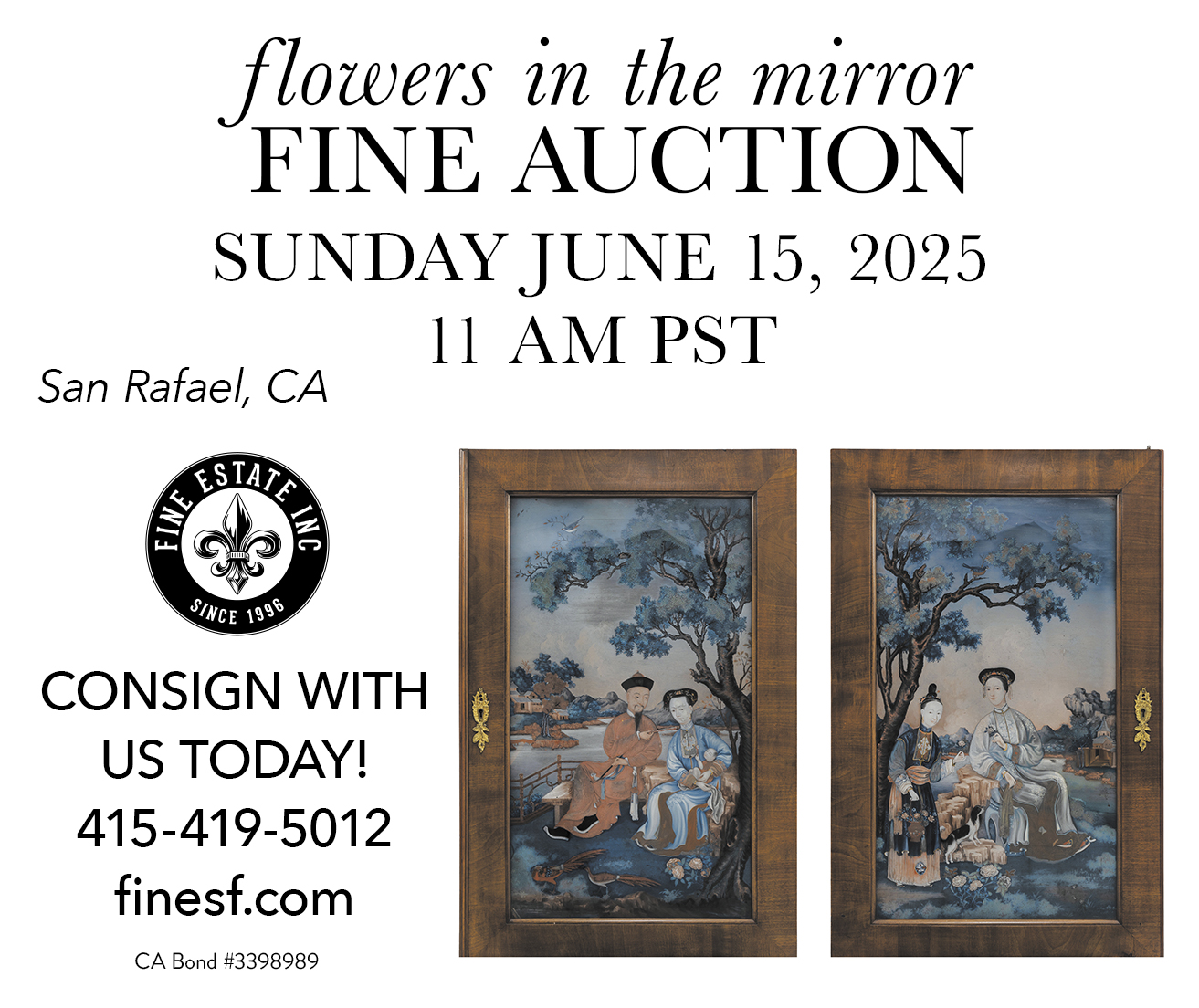American Indian & Western Art
September 20th, 2013
|
Crow Encampment by Joseph Henry Sharp (1859-1953), oil on canvas, signed, 22" x 26½" plus original southwestern frame, relined, otherwise in fine condition, $309,000.
Red River Metis quilled-hide knife sheath, 13½" long, with an unmarked Sheffield-made dag knife, circa 1830, $54,000. Sinew-sewn on softly tanned buckskin and quilled using porcupine quills dyed in red, blue, and cream, the sheath having a birch-bark liner, while the hide fringe is banded with wrapped quillwork and finished with loops. The knife’s handle is composed of water buffalo horn, bone, and brass rivets. Marvin L. Lince collection.
Eastern Great Lakes effigy burl bowl, carved ash decorated on one side with a stylized effigy, possibly a bear’s head, 4" high x 13¼" diameter, $18,000.
Great Lakes pipe tomahawk with brass and silver inlay and a tiger maple haft, 19th century, 22" long, $93,000. The forged head has a tulip-shaped bowl, while engraved inlay of flowers and stars decorates the bowl and blade. Marvin L. Lince collection.
Western Plains pipe tomahawk with antelope drop, fourth quarter of the 19th century, 22" long, $60,000. The forged blade has double cutouts outlined with dots. The bowl is embellished with three hatched rings. The highly polished and file-branded haft is studded with brass tacks at the ends and decorated with two deeply incised X’s on one side and a crosshatch on other. In the shape of antelope horns, a rawhide drop in blue and white beads is attached to the haft with a hide thong. Marvin L. Lince collection. |
Cowan’s Auctions, Cincinnati, Ohio
Photos courtesy Cowan’s
On the strength of two vastly different collections, the September 20 American Indian and Western art sale conducted by Cowan’s Auctions in Cincinnati, Ohio, grossed more than $1.2 million. Leading the way was a pair of Joseph Henry Sharp paintings from a Cincinnati home and Native American material from Marvin L. Lince of Oregon.
Topping all bids was Crow Encampment by Sharp (1859-1953), an oil on canvas work showing two figures near a campfire outside a pair of teepees adjacent to the Little Bighorn River. Measuring 22" x 26½", plus the original southwestern frame, the snowy landscape realized $309,000 (includes buyer’s premium), well above its estimate of $80,000/120,000.
The scene was likely painted in the first decade of the 20th century. From 1905 to 1909, Sharp spent time on the Crow Agency in Montana, creating a number of large encampment scenes. Around 1910 he shifted his efforts almost exclusively to Taos, New Mexico, concentrating on a different genre of work—vibrant images that were often more formulaic in nature. That later work typically featured southwestern Indians who modeled for the artist in their Pueblo homes or in the surrounding desert.
Although the Taos paintings defined Sharp’s career, the Plains works command greater interest because of their scarcity. “The Montana scenes never show up,” said Graydon Sikes, Cowan’s director of paintings and prints.
The strength of the bidding reflected a combination of factors—the scarcity, size, quality, and freshness of the painting. Sikes was thrilled with the result. “That is a great price,” he said.
A second Sharp painting from the same consignor was Pueblo Drummer, an 18" x 12" oil on canvas showing a seated figure holding a drum. Signed and inscribed “Taos, N.M.,” this painting was also in its original southwestern frame. Bidding went to $99,000 on an estimate of $40,000/60,000.
An example of Sharp’s recurring work in Taos, Pueblo Drummer was probably painted in the 1920’s, at the peak of the artist’s career. The catalog noted, “Loose, colorful brushstrokes, typical of the Taos School modernists, combined with an attention to light are present in the best of Sharp’s Taos works. The sitter, also known as Elk Foot Jerry or ‘Hunting Son,’ often posed for Sharp. It is conceivable that Sharp had a hand in the construction of, or at least the matching of, the frame for this painting.”
The Taos scene wasn’t unusual, but it was good. “It was very typical, but it had everything right going for it. It was never restored and was probably in its original frame,” said Sikes. “And again, it was buried for a long time.”
Both works originated from the private collection of a Cincinnati family that bought Western art in the 1940’s through the 1960’s. Passed down to a daughter who consigned them, these two paintings returned to the market for the first time in decades. They sold on the phone to the same bidder in Montana.
“There are a lot of collections in Cincinnati that have [Henry] Farnys and Sharps. Those two artists spent their time here,” said Sikes. “There’s just a ton of great Western paintings buried here in Cincinnati.”
From a second consignor came a monotype Indian portrait by Sharp, 14" x 11", plus the original frame, that sold for $5400. “I actually thought that was pretty soft,” said Sikes. “It’s basically watercolor on glass that he turns over and makes that impression on paper. That was one-of-a-kind…Down the road, I think, once people realize how rare they are, they will bring much, much more.” The buyer was a Cincinnati collector.
The market for Sharp’s art has rebounded nicely, according to Sikes. “I was terrified of Sharp for a while. There were a couple of years there where he was really soft.”
The other main draw of the auction was a grouping of material from the Lince collection. Lince became interested in Indian arts in the late 1980’s, buying top-notch examples and often paying top-dollar prices. Cowan’s first sold a selection of material from the collection in April. At that auction, an Eastern Plains three-bladed knife club realized $180,000.
This second go-round featured 17 lots, topped by a Great Lakes pipe tomahawk with brass and silver inlay and a tiger maple haft selling for $93,000. The piece had a forged head with a tulip-shaped bowl engraved with flowers and stars.
A Western Plains pipe tomahawk sold for $60,000. The forged blade had double cutouts outlined with dots, while the barrel-shaped bowl was embellished with three hatched rings. The file-branded haft was studded with brass tacks and incised with X’s and crosshatch marks. Attached to the haft was a beaded drop in the form of antelope horns.
A dag knife having a beaded sheath, said to have been owned by Crowfoot (d. 1890), a Blackfoot chief, sold for $78,000. The blacksmith-made knife had a maple handle detailed with two brass tacks, while the sheath was in a variety of colored beads. A Red River Metis quilled-hide knife sheath and a Sheffield-made dag knife sold together for $54,000.
The variety of lots from the Lince collection included a Cheyenne beaded buffalo-hide cradle at $37,200; a Blackfoot bow made from a single elk antler, $18,000; and a Lakota Sioux polychrome courting flute that sold for $8400.
“I was fairly pleased with the results for the second portion,” said Danica Farnand, Cowan’s director of American Indian art. The final grouping of material from Lince’s collection will be offered by Cowan’s in April.
Other items in the auction also did well. “There was a lot of interest in the really good stuff and the unique pieces,” Farnand said. “Overall, I thought the sale was a fairly exciting auction.”
Highlights included a Navajo woman’s dress that sold for $24,000; a Thompson River beaded-hide war shirt and leggings, $22,800; an Eastern Great Lakes burl bowl having a bear effigy, $18,000; a Navajo first-phase concha belt, $13,200; and two Navajo room-size Ganado weavings at $12,000 each.
The two weavings typified this specific auction, as well as the market in general, which continues to run hot and cold. Great items are still finding steady interest, while mediocre material often struggles. “The more ordinary stuff is tough to sell,” said Farnand. That’s not the case with better pieces, like the large weavings. “The room-size weavings are really nice pieces—great imagery, great color, I think that’s why they did what they did.”
For more information, phone (513) 871-1670 or visit (www.cowanauctions.com).
|
|
|
|
|
|
Originally published in the December 2013 issue of Maine Antique Digest. © 2013 Maine Antique Digest



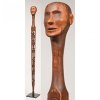




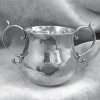
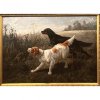



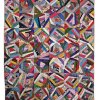

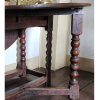




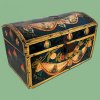




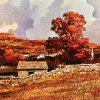







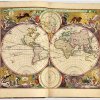











 Blackfeet dag knife with beaded-hide sheath used by Crowfoot (d. 1890), $78,000. Blacksmith-made knife with maple handle detailed with two brass tacks, 16¾" long. Sinew-sewn buffalo hide sheath lined with rawhide and beaded in light blue, dark blue, red white-heart, pink, greasy yellow, and pea green. This lot included an 1888 letter on United States Indian Service letterhead at the Blackfeet Indian Agency stating the knife was owned by Crowfoot. Marvin L. Lince collection.
Blackfeet dag knife with beaded-hide sheath used by Crowfoot (d. 1890), $78,000. Blacksmith-made knife with maple handle detailed with two brass tacks, 16¾" long. Sinew-sewn buffalo hide sheath lined with rawhide and beaded in light blue, dark blue, red white-heart, pink, greasy yellow, and pea green. This lot included an 1888 letter on United States Indian Service letterhead at the Blackfeet Indian Agency stating the knife was owned by Crowfoot. Marvin L. Lince collection. Cheyenne beaded buffalo hide cradle, fourth quarter of the 19th century, 40" long, a couple of repairs to the hide, a small hole in the back, $37,200. Sinew-sewn using beads of dark blue, greasy yellow, pea green, red white-heart, and white. The cradle is mounted on thin wooden slats decorated with brass tacks; the wood is further embellished with red pigment and forked tips. Marvin L. Lince collection.
Cheyenne beaded buffalo hide cradle, fourth quarter of the 19th century, 40" long, a couple of repairs to the hide, a small hole in the back, $37,200. Sinew-sewn using beads of dark blue, greasy yellow, pea green, red white-heart, and white. The cradle is mounted on thin wooden slats decorated with brass tacks; the wood is further embellished with red pigment and forked tips. Marvin L. Lince collection.

 Thompson River beaded hide war shirt and leggings, late 19th century, $22,800. Thread- and sinew-sewn, having applied strips beaded in light blue, dark blue, greasy yellow, and red white-heart.
Thompson River beaded hide war shirt and leggings, late 19th century, $22,800. Thread- and sinew-sewn, having applied strips beaded in light blue, dark blue, greasy yellow, and red white-heart. Pueblo Drummer by Joseph Henry Sharp (1859-1953), oil on canvas, signed and inscribed “Taos, NM,” title inscribed on reverse, 18" x 12" plus original gilt and gesso southwestern frame, cleaned at one time, otherwise untouched and under glass, $99,000.
Pueblo Drummer by Joseph Henry Sharp (1859-1953), oil on canvas, signed and inscribed “Taos, NM,” title inscribed on reverse, 18" x 12" plus original gilt and gesso southwestern frame, cleaned at one time, otherwise untouched and under glass, $99,000. Navajo Classic woman’s dress, two panels finely woven of raveled two-ply bayeta, lac- and cochineal-dyed with native handspun indigo blue and dark-brown/black, circa 1865, 49" x 33¼", $24,000.
Navajo Classic woman’s dress, two panels finely woven of raveled two-ply bayeta, lac- and cochineal-dyed with native handspun indigo blue and dark-brown/black, circa 1865, 49" x 33¼", $24,000.


